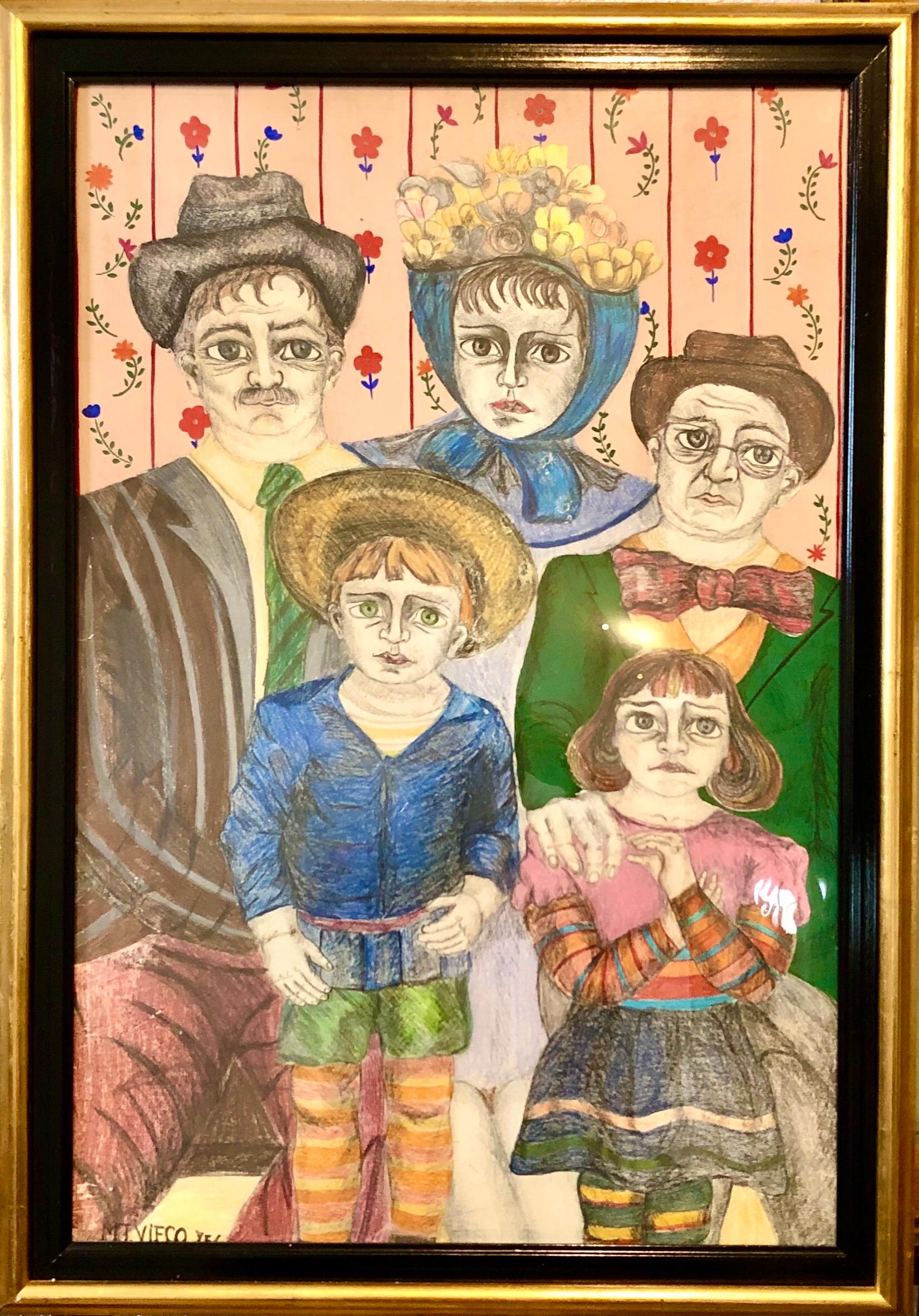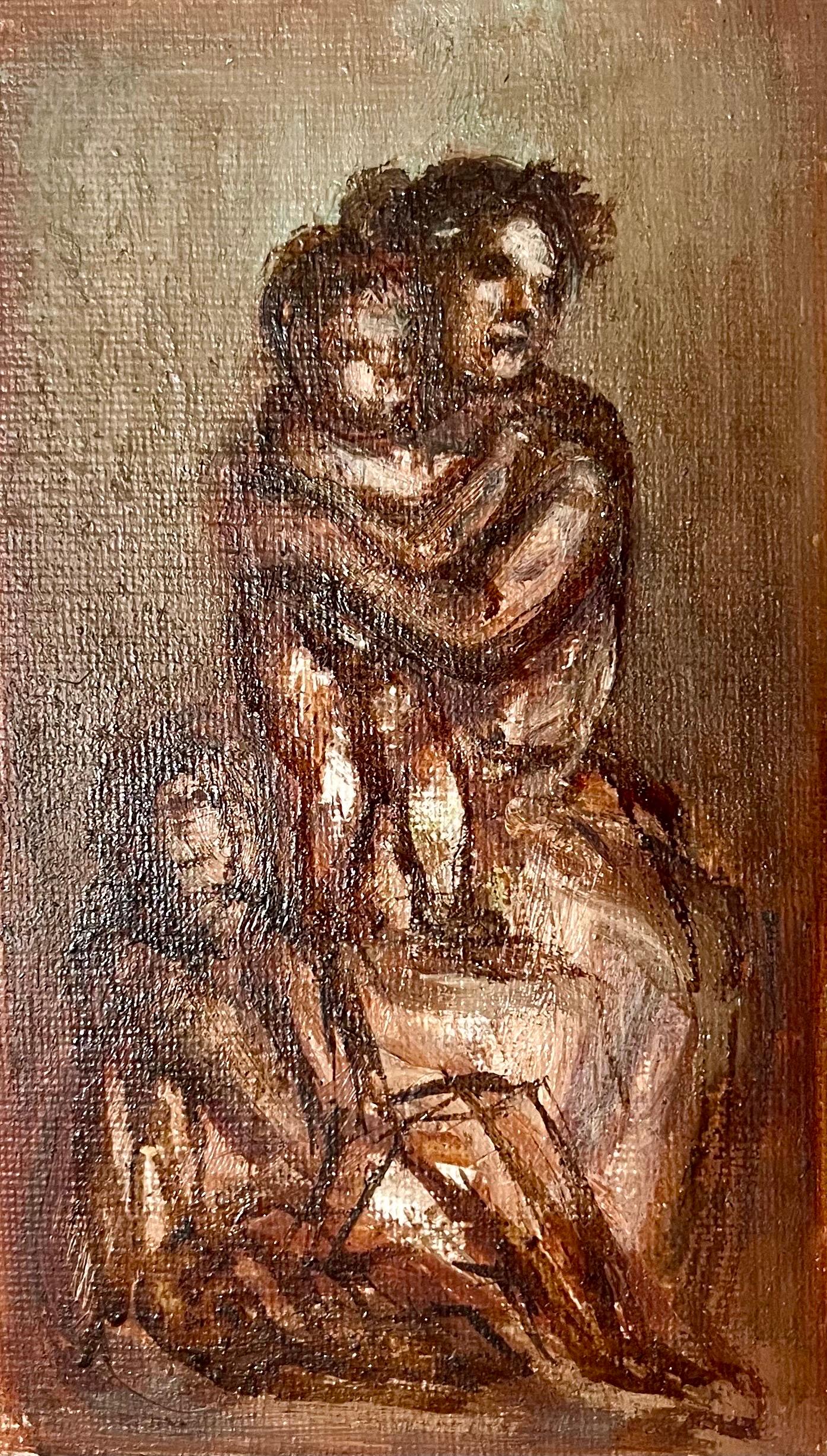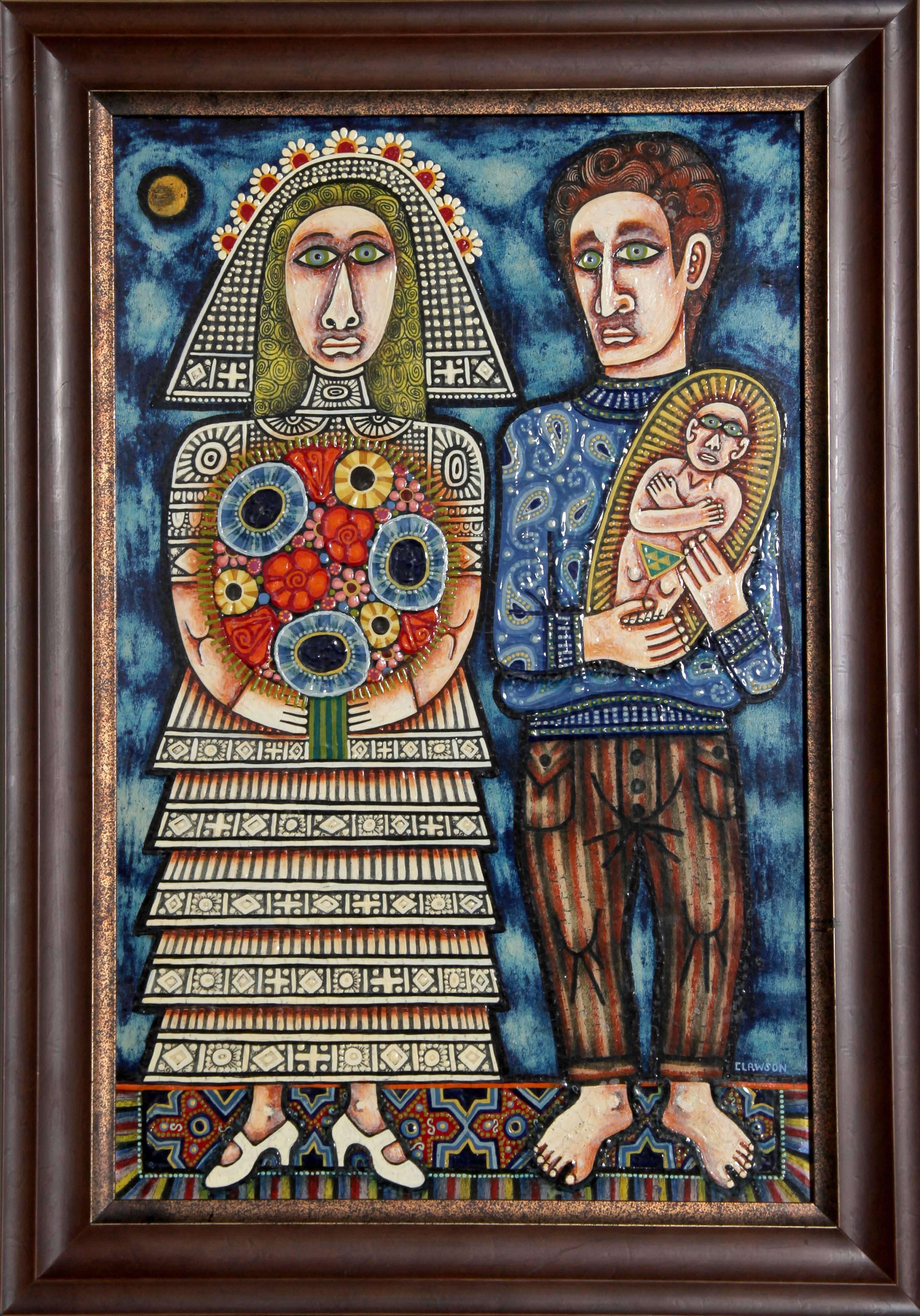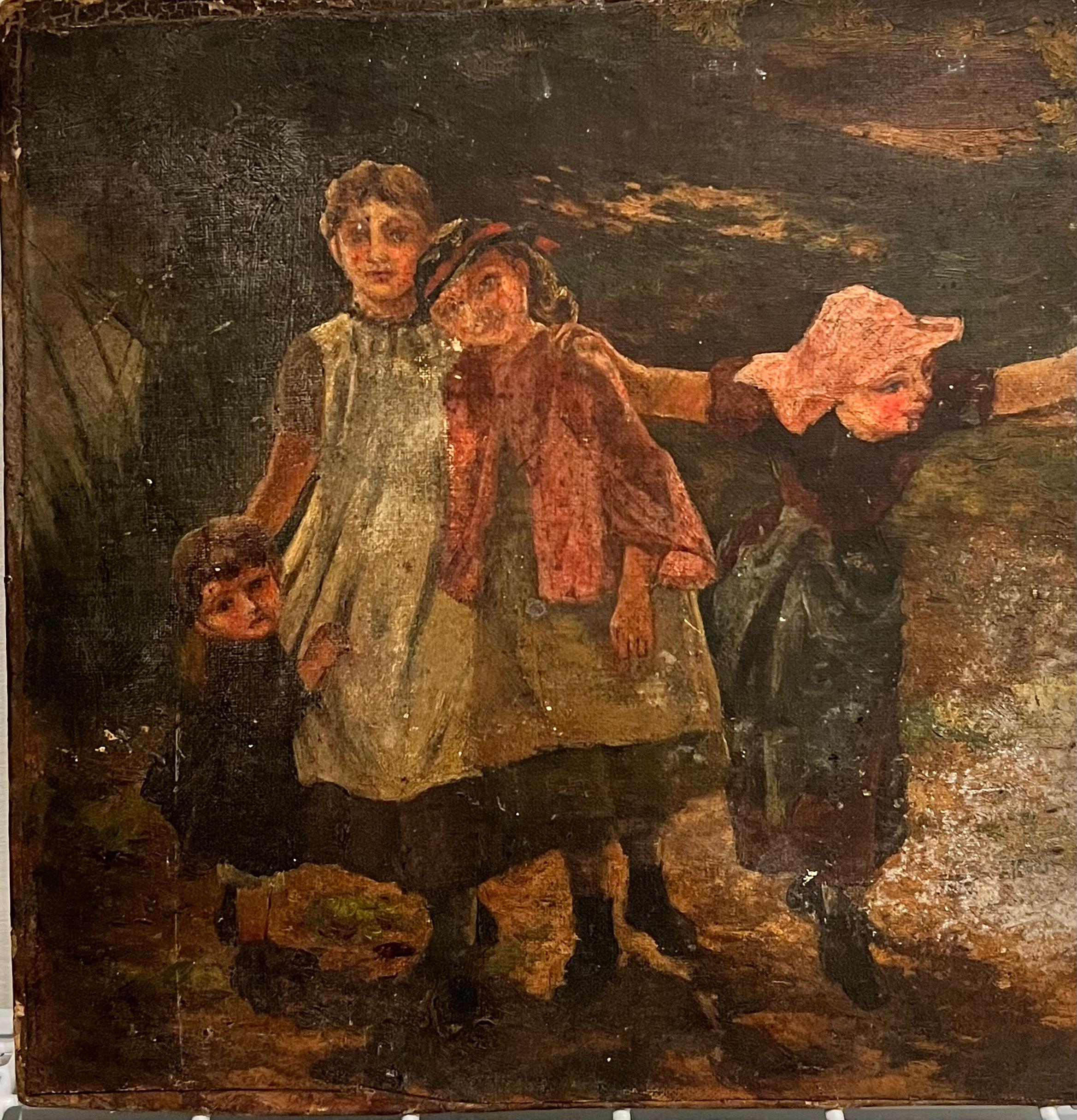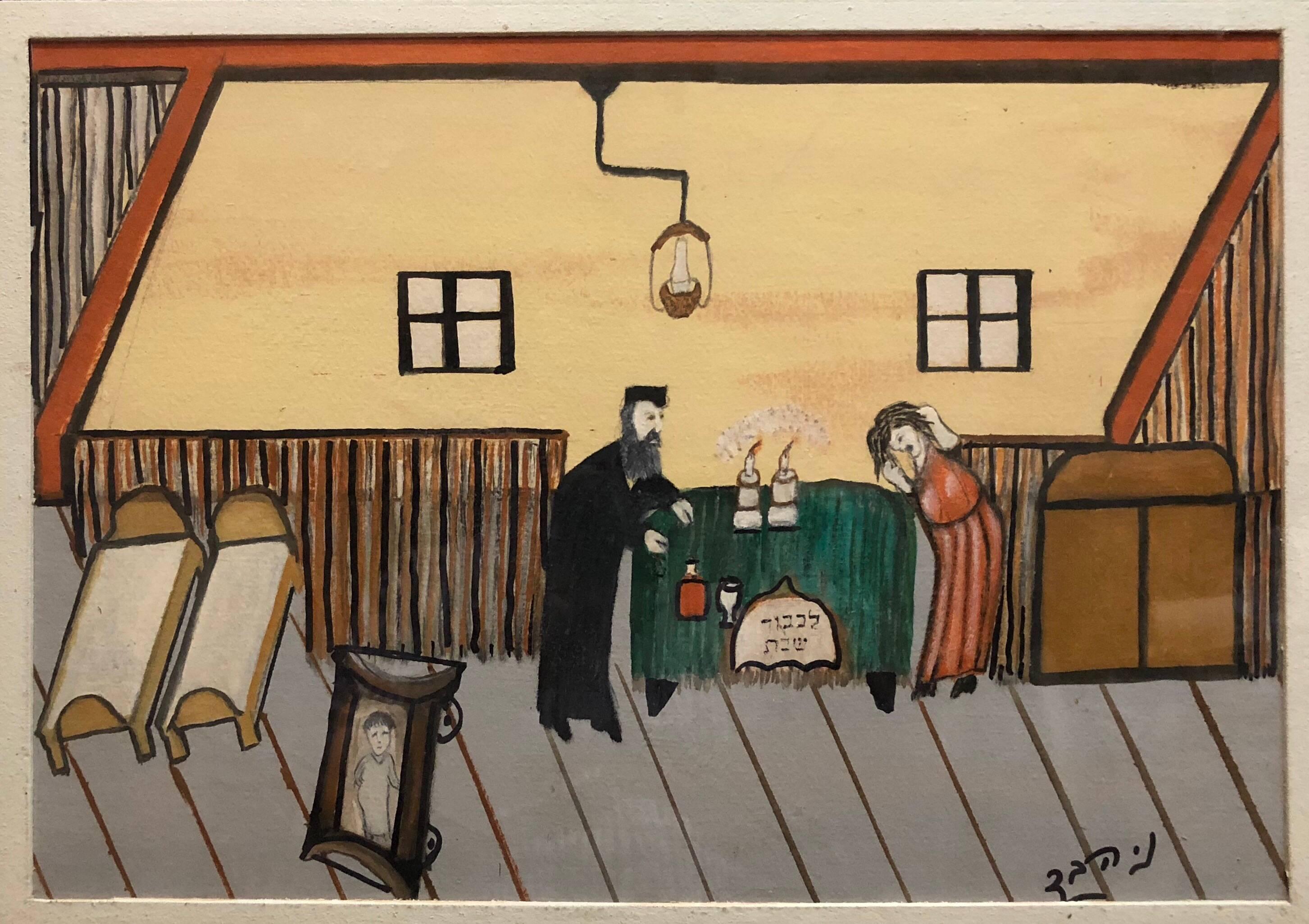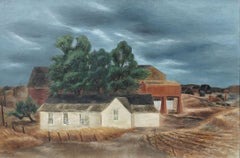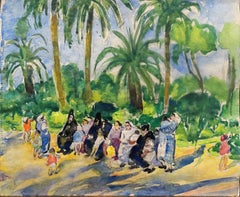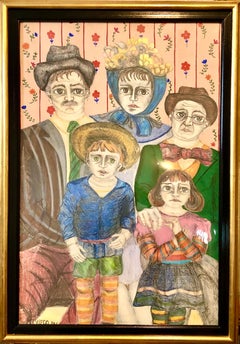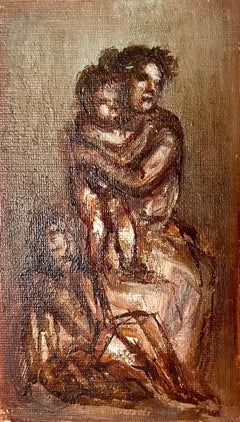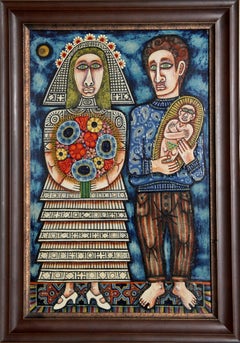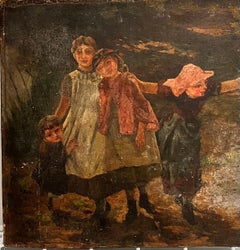Items Similar to "Overholser Family, 1890, Sterling, Illinois" Streeter Blair, 1949 Painting
Want more images or videos?
Request additional images or videos from the seller
1 of 6
Streeter Blair"Overholser Family, 1890, Sterling, Illinois" Streeter Blair, 1949 Painting1949
1949
$4,800
£3,644.75
€4,168.05
CA$6,706.30
A$7,458.87
CHF 3,894.79
MX$90,766.45
NOK 49,742.38
SEK 46,649.58
DKK 31,107.74
Shipping
Retrieving quote...The 1stDibs Promise:
Authenticity Guarantee,
Money-Back Guarantee,
24-Hour Cancellation
About the Item
Streeter Blair
Overholser Family, 1890, Sterling, Illinois, 1949
Signed, titled, and dated lower left
Oil on canvas
8 x 10 inches
Primitive painter Streeter Blair is renowned for his naive, sentimental depictions of America's past. In mood and style, his paintings of children, little villages, farmhouses, buggies, and historical events are comparable to Grandma Moses's.
Blair's early years spent on a farm in Cadmus, Kansas, are depicted in a number of his paintings. Others recreate historical scenes, such the first electric streetlight in Los Angeles and a street in Virginia City, Nevada, a town that was a gold rush town. His topics are thoroughly investigated and precise down to the last detail.
After a lifetime of pursuing various interests as a school principal, teacher, coach, editor, and eventually owner of an antique shop, Blair finally realized he could paint at the age of sixty. He painted partly because he needed to describe the barns and farmhouses in Pennsylvania where he bought his antiques. He claimed to have painted a painting of one of these barns and displayed it at the antique store. After inquiring if it was for sale, a female buyer paid $25 for it.
Blair had some prior artistic experience, but this was the beginning of his artistic career. He produced the content and contributed some graphics for the boys' magazine The Knicker, which he published in the 1920s and 1930s.
Blair abandoned nearly everything else to paint for the following eighteen years, developing a reputation as a highly skilled yet archaic painter. Up until 1961, he kept up his antique business in Los Angeles and Leucadia. A Beverly Hills art gallery exhibited Blair's work retrospectively in 1970, a few years after his passing, and sold paintings for as much as $25,000.
Blair, like Grandma Moses, declined to receive traditional painting training, which is evident in the way he handles shadowing, perspective, and scale relativity. His people are frequently bigger than their horses, and his rivers appear to flow uphill. The joy of childhood, as recalled by an adult who has chosen to forget the struggles of living in rural America at the turn of the century, is depicted in his work with a charming, nostalgic glow.
Blair was a lively man who had friends all the time. They would gather around his fireplace, sip coffee, eat the bread he had baked that won an award, and listen to his stories about his time in Kansas. This group included a number of avant-garde artists, such as Billy Al Bengston and Edward Kienholz.
Examples of Blair's work can be found in a number of private collections as well as public collections such as the Smithsonian Institution, Washington, D.C.; the University of Kansas, Spencer Art Museum; the Hirschhorn Collection, Washington, D.C.; the Los Angeles County Museum of Art; the Museum of Fine Arts, San Diego; the National Gallery, Washington, D.C.; the Santa Barbara Museum of Art; and the Smithsonian Institution, Washington, D.C.
- Creator:Streeter Blair (1888 - 1966, American)
- Creation Year:1949
- Dimensions:Height: 8 in (20.32 cm)Width: 10 in (25.4 cm)
- More Editions & Sizes:Unique WorkPrice: $4,800
- Medium:
- Movement & Style:
- Period:
- Framing:Framing Options Available
- Condition:
- Gallery Location:New York, NY
- Reference Number:1stDibs: LU1841215802932
About the Seller
5.0
Platinum Seller
Premium sellers with a 4.7+ rating and 24-hour response times
Established in 2022
1stDibs seller since 2022
115 sales on 1stDibs
Typical response time: <1 hour
- ShippingRetrieving quote...Shipping from: New York, NY
- Return Policy
Authenticity Guarantee
In the unlikely event there’s an issue with an item’s authenticity, contact us within 1 year for a full refund. DetailsMoney-Back Guarantee
If your item is not as described, is damaged in transit, or does not arrive, contact us within 7 days for a full refund. Details24-Hour Cancellation
You have a 24-hour grace period in which to reconsider your purchase, with no questions asked.Vetted Professional Sellers
Our world-class sellers must adhere to strict standards for service and quality, maintaining the integrity of our listings.Price-Match Guarantee
If you find that a seller listed the same item for a lower price elsewhere, we’ll match it.Trusted Global Delivery
Our best-in-class carrier network provides specialized shipping options worldwide, including custom delivery.More From This Seller
View All"The Marriage Proposal (Family Gathering), " Leo Schutzman, Jewish Folk Art
By Leo Schutzman
Located in New York, NY
Leo Schutzman (1878 - 1962)
The Marriage Proposal, circa 1958
Oil on canvas
24 x 20 inches
Signed lower left
Leo (Kyle) Schutzman (1878-1962) developed ...
Category
1950s Folk Art Figurative Paintings
Materials
Canvas, Oil
"Glasco Landscape" Albert Heckman, circa 1940 New York Modernist Landscape
By Albert Heckman
Located in New York, NY
Albert Heckman
Glasco Landscape, circa 1940
Signed lower right
Oil on canvas
25 1/4 x 39 1/2 inches
Albert Heckman was born in Meadville, Western Pennsylvania, 1893. He went to New York City to try his hand at the art world in 1915 after graduating from high school and landing a job at the Meadville Post Office. In 1917, at the age of 24, Heckman enrolled part-time in Teachers' College, Columbia University's Fine Arts Department to begin his formal art education. He worked as a freelance ceramic and textile designer and occasionally as a lecturer at the Metropolitan Museum of Art. In the early 1920s, at the age of almost 30, he graduated with a Bachelor of Arts degree from Columbia Teachers College. He was especially impacted by his instructor at Columbia, Arthur Wesley Dow.
After graduating, he was hired by the Teachers' College as a Fine Arts instructor. He stayed with Columbia Teachers' College until 1929, when he left to attend the Leipzig Institute of Graphic Arts in Leipzig, Germany. Isami Doi (1903-1965), who was born in Hawaii, was arguably his most impressive student at Columbia. Doi is now regarded as one of the most prominent artists hailing from Hawaii. Heckman became an active member and officer of the Keramic Society and Design Guild of New York in the 1920s as part of his early commercial art career. The Society's mission was to share knowledge and showcase textile and ceramic design exhibits.
In 1922, Heckman married Florence Hardman, a concert violinist. Mrs. Heckman's concert schedule during the 1920s kept Albert and Florence Heckman apart for a significant portion of the time, but they spent what little time they had together designing and building their Woodstock, New York, summer house and grounds. A small house and an acre of surrounding land on Overlook Mountain, just behind the village of Woodstock, were purchased by Albert and Florence Heckman at the time of their marriage. Their Woodstock home, with its connections, friendships, and memories, became a central part of their lives over the years, even though they had an apartment in New York City.
Heckman's main artistic focus shifted to the house on Overlook Mountain and the nearby towns and villages, Kingston, Eddyville, and Glasco. After returning from the Leipzig Institute of Graphic Arts in 1930, Mr. Heckman joined Hunter College as an assistant professor of art. He worked there for almost thirty years, retiring in 1956. Throughout his tenure at Hunter, Mr. Heckman and his spouse spent the summers at their Woodstock residence and the winters in New York City. They were regular and well-known guests at the opera and art galleries in New York. Following his retirement in 1956, the Heckmans settled in Woodstock permanently, with occasional trips to Florida or Europe during the fall and winter. Mr. Heckman's close friends and artistic career were always connected to Woodstock or New York City. He joined the Woodstock art group early on and was greatly influenced by artists like Paul and Caroline Rohland, Emil Ganso, Yasuo Kuniyoshi, Andre Ruellan, and her husband, Jack...
Category
1940s American Modern Figurative Paintings
Materials
Canvas, Oil
"Families near Seville, Spain" Martha Walter, Modernist Figures in Landscape
By Martha Walter
Located in New York, NY
Martha Walter
Families near Seville, Spain
Signed lower left
Watercolor on paper
7 x 8 inches
Martha Walter was best known as a painter of colorful beach scenes and landscapes. Inf...
Category
Early 20th Century American Modern Figurative Drawings and Watercolors
Materials
Paper, Watercolor
"On the Upper Mississippi" Delle Miller, Missouri Regionalist Landscape
Located in New York, NY
Delle Miller
On the Upper Mississippi, circa 1926
Signed lower left
Oil on canvas
26 1/8 x 29 1/8 inches
By 1909, Miller was an instructor at the Kansas...
Category
1920s American Modern Landscape Paintings
Materials
Canvas, Oil
$9,600 Sale Price
20% Off
"Johnny Walker’s Place" Georgina Klitgaard, 1929 American Modernist Landscape
By Georgina Klitgaard
Located in New York, NY
Georgina Klitgaard
Johnny Walker’s Place, circa 1929
Signed lower right
Oil on canvas
34 x 42 inches
Georgina Klitgaard’s art has sometimes gotten lost in the critical propensity t...
Category
1920s American Modern Figurative Paintings
Materials
Oil
"Along the Kanahawa River, West Virginia, " Ernest Fiene, WPA Coal Steamboat
By Ernest Fiene
Located in New York, NY
Ernest Fiene
Along the Kanahawa River, West Virginia, 1936
Signed lower right
Oil on canvas
26 x 36 inches
Fiene made a series of paintings, drawings and lithographs which are based on his travels through Pennsylvania and West Virginia during the winter of 1935-36. The industrial areas of Pennsylvania and West Virginia are represented in numerous oils, among which are some of his most well-known. Fiene wrote of the trip, "The increasing snow and atmospheric conditions [in the Kanawha River valley} enhanced this mountainous coal mining country with a majestic beauty."
Winter on the River is Fiene's only American Artists Group print and there were only two lithographs produced from the West Virginia trip. The American Artists Group (AAG), under the direction of Carl Zigrosser, who was then working at New York's famed Weyhe Gallery, published ninety-three prints by over fifty artists in 1936 and 1937. Zigrosser's goal was to popularize contemporary American art through original prints offered at the low price of $2.75. The project was also a means to provide income for impoverished artists during the Depression. The prints were featured in many of the leading print exhibitions and publications of the period. The lithograph produced from this image is now in the collection of the Amon Carter Museum, Baltimore Museum of Art, Cleveland Museum of Art, Philadelphia Museum of Art, Pensacola Museum of Art, San Francisco Fine Arts Museum, Syracuse Museum, Yale University Art Museum.
Ernest Fiene was born in Elberfeld, Germany in 1894. As a teenager, Fiene immigrated to the United States in 1912. He studied art at the National Academy of Design in New York City from 1914 to 1918, taking day classes with Thomas Maynard and evening classes with Leon Kroll. Fiene continued his studies at the Beaux-Arts Institute of Design in New York from 1916 to 1918, adding classes in printmaking at the Art Students League in 1923.
Fiene began his career as an artist in 1919 with his first exhibition of watercolors at the MacDowell Club arranged by his mentor Robert Henri. In 1923 the Whitney Studio Club mounted a large exhibition of his works. The following year he had an exhibition at the New Gallery in New York, which completely sold out all fifty-two works, including paintings, watercolors, drawings, and etchings. With the proceeds of sales from the New Gallery exhibition, Ernest Fiene and his younger brother Paul, a sculptor, built studios in Woodstock, New York in 1925.
In the early Twenties Ernest Fiene painted mostly landscapes of Woodstock and both the Ramapo and Hudson River Valleys. The first monograph from the Younger Artists Series was published on Fiene in 1922. Published in Woodstock, the series went on to include Alexander Brook, Peggy Bacon, and Yasuo Kuniyoshi. The book reproduced 1 illustration in color and another 27 reproductions in black and white. Around 1925 Fiene became fascinated with the intensity, excitement, and opportunities for color harmonies New York City offered as a subject. His paintings shifted to urban and industrial themes with architecture, industry, and transportation becoming his subjects.
By 1926 Fiene had attracted the dealer Frank K.M. Rehn, who gave him a one-man exhibition that year, which travelled to the Boston Arts Club. C.W. Kraushaar Galleries gave Fiene a one-man exhibition of urban, landscape, portrait, and still life paintings in 1927. Julianna Force, the director of the Whitney Studio Club and first director of the Whitney Museum of American Art, included two of Fiene’s paintings in a fall exhibition in 1928. The Whitney Studio Club showed Fiene’s paintings in a two-man exhibition with Glenn O. Coleman that year and acquired three of Fiene’s paintings. Also in 1928 Fiene became affiliated with Edith Halpert’s Downtown Gallery where he had an exhibition of 20 lithographs in the spring. Fiene sold his house in Woodstock in 1928 to spend more of his time in New York City.
With so many successful exhibitions, Fiene returned to Paris in 1928-29 where he rented Jules Pascin's studio and studied at the Académie de la Grande Chaumière. In France, Fiene painted both landscape and urban subjects developed from ideas influenced by Cubist geometry and the use of flat areas of broad color. Upon returning to New York in 1930, Fiene used this new approach to continue to paint New York skyscraper and waterfront subjects, as well as to begin a series of paintings on changing old New York based on the excavations for Radio City Music Hall and the construction of the Empire State Building. Frank K.M. Rehn Galleries exhibited this series, titled “Changing Old New York,” in 1931. Fiene also has solo exhibitions at Rehn Galleries in 1930 and 1932. Fiene’s oil paintings are exhibited at the Chicago Arts Club in 1930 as well.
Fiene was included in the Museum of Modern Art’s exhibition Painting and Sculpture by Living Americans in December of 1931. Visiting New York, Henri Matisse saw the exhibition and called Fiene’s Razing Buildings, West 49th Street the finest painting he had seen in New York. Fiene had two mural studies from his Mechanical Progress series exhibited at the Museum of Modern Art’s exhibition Murals by American Painters and Photographers in 1932. Fiene sent View from my Window which depicts Fiene working on a lithograph stone while looking out his window to the newly completed Empire State Building to the Carnegie International in 1931. In 1932 Fiene participated in the first Biennial of American Painting at the Whitney Museum and his prints were included in exhibitions at the Downtown Gallery and the Wehye Gallery. In the same year, Fiene was awarded a Guggenheim fellowship to further study mural painting in Florence, Italy.
On his return from Italy in 1933 Fiene re-engaged himself in New York City life and won several public and private mural projects. Fiene resumed his active exhibition schedule, participating in two group exhibitions at the Whitney Museum and a one-man exhibition of recent paintings at the Downtown Gallery in January 1934. In 1933 he purchased a farm in Southbury, Connecticut, which added Connecticut scenes to his landscape subjects. This was also the year Fiene began to spend summers on Monhegan Island, Maine, where he painted seascapes, harbor scenes, and still lifes.
Fiene’s landscape paintings attracted numerous commissions as part of the American Scene movement. Through the fall and winter of 1935-36, Fiene took an extended sketching trip through the urban, industrial, and farming areas of Pennsylvania and West Virginia. Most of the twenty-four Pennsylvania urban and rural paintings from this trip were featured in an exhibition held at the First National Bank in Pittsburgh in October of 1937 by the Pittsburgh Commission for Industrial Expansion. Fiene said of these works that he formed rhythm, opportunity for space and color, and integrity in the Pennsylvania mill and furnace paintings. Fiene received the silver medal for one of the Pittsburgh paintings...
Category
1930s American Realist Landscape Paintings
Materials
Oil, Canvas
$8,000 Sale Price
20% Off
You May Also Like
Latin American Folk Art Family Portrait Colombian Naive Painting, Color Drawing
Located in Surfside, FL
Folk art, Naive, Latin American art , Family portrait in the style of a Chinese ancestor portrait.
Maria Teresa Vieco is a Colombian artist born in 1953 in Bogota. She studied at th...
Category
1970s Folk Art Portrait Paintings
Materials
Paper, Pastel, Acrylic, Pencil
Simka Simkhovitch WPA Artist Oil Painting Family Mother, Kids American Modernist
By Simka Simkhovitch
Located in Surfside, FL
Simka Simkhovitch (Russian/American 1893 - 1949)
This came with a small grouping from the artist's family, some were hand signed some were not.
These were studies for larger paintings.
Simka Simkhovitch (Симха Файбусович Симхович) (aka Simka Faibusovich Simkhovich) (Novozybkov, Russia May 21, 1885 O.S./June 2, 1885 N.S.—Greenwich, Connecticut February 25, 1949) was a Ukrainian-Russian Jewish artist and immigrant to the United States. He painted theater scenery in his early career and then had several showings in galleries in New York City. Winning Works Progress Administration (WPA) commissions in the 1930s, he completed murals for the post offices in Jackson, Mississippi and Beaufort, North Carolina. His works are in the permanent collections of the Dallas Museum of Art, the National Museum of American Art and the Whitney Museum of American Art. Born outside Kyiv (Petrograd Ukraine) into a Jewish family who owned a small department store. During a severe case of measles when he was seven, Simcha Simchovitch sketched the views outside his window and decided to become an artist, over his father's objections. Beginning in 1905, he studied at the Grekov Odessa Art School and upon completion of his studies in 1911 received a recommendation to be admitted to the Imperial Academy of Arts. Though he enrolled to begin classes in architecture, painting, and sculpture at the Imperial Academy, he was dropped from the school roster in December because of the quota on the number of Jewish students and drafted into the army. Simchovitch served as a private in the 175th Infantry Regiment Baturyn [ru] until his demobilization in 1912. Re-enrolling in the Imperial Academy, he audited classes.
Simka Simkhovitch exhibited paintings and sculptures in 1918 as part of an exhibition of Jewish artists and in 1919 placed 1st in the competition "The Great Russian Revolution" with a painting called "Russian Revolution" which was hung in the State Museum of Revolution. In 1922, Simkha Simkhovitch exhibited at the International Book Fair in Florence (Italian: Fiera Internazionale del Libro di Firenze). In 1924, Simkhovitch came to the United States to make illustrations for Soviet textbooks and decided to immigrate instead. Initially he supported himself by doing commercial art and a few portrait commissions. In 1927, he was hired to paint a screen for a scene in the play "The Command to Love" by Fritz Gottwald and Rudolph Lothar which was playing at the Longacre Theatre on Broadway. Art dealers began clamoring for the screen and Simkhovitch began a career as a screen painter for the theater. Catching the attention of the screenwriter, Ernest Pascal, he worked as an illustrator for Pascal, who then introduced him to gallery owner, Marie Sterner. Simkhovitch's works appeared at the Marie Sterner Gallery beginning with a 1927 exhibit and were repeated the following year. Simkhovitch had an exhibit in 1929 at Sterner's on circus paintings. In 1931, he held a showing of works at the Helen Hackett Gallery, in New York City and later that same year he was one of the featured artists of a special exhibit in San Francisco at the California Palace of the Legion of Honor in Lincoln Park. The exhibit was coordinated by Marie Sterner and included four watercolors, including one titled "Nudes". He is of the generation of Russian Soviet artists such as Isaac Pailes, Serge Charchoune, Marc Chagall, Chana Orloff, Isaac Ilyich Levitan, and Ossip Zadkine.
In 1936, Simkhovitch was selected to complete the mural for the WPA Post office project in Jackson, Mississippi. The mural was hung in the post office and courthouse in 1938 depicted a plantation theme. Painted on the wall behind the judge’s bench, “Pursuits of Life in Mississippi”, a depiction of black workers engaged in manual labor amid scenes of white professionals and socialites, was eventually covered over in later years during renovations due to its stereotypical African American imagery. The following year, his painting "Holiday" won praise at an exhibition in Lincoln, Nebraska. In 1940, Simkhovitch's second WPA post office project was completed when four murals, "The Cape Lookout Lighthouse and the Orville W. Mail Boat", "The Wreck of the Crissie Wright", "Sand Ponies" and "Canada Geese" were installed in Beaufort, North Carolina. The works were commissioned in 1938 and did not generate the controversy that the Jackson mural had. The main mural is "The Wreck of the Crissie Wright" and depicts a shipwreck which had occurred in Beaufort in 1866. "The Cape Lookout Lighthouse and the Orville W. Mail Boat" depicted the lighthouse built in 1859 and the mail boat that was running mail during the time which Simkhovitch was there. The boat ran mail for the area until 1957. "Sand Ponies" shows the wild horses common to the North Carolina barrier islands and "Canada Geese" showed the importance of hunting and fishing in the area. All four murals were restored in the 1990s by Elisabeth Speight, daughter of two other WPA muralists, Francis Speight...
Category
1930s American Modern Figurative Paintings
Materials
Oil, Board
Family, Folk Art Oil Painting on Board by Rex Clawson
By Rex Clawson
Located in Long Island City, NY
Artist: Rex Clawson, American (1929 - 2007)
Title: Family
Year: circa 1979
Medium: Oil on Board, signed l.r.
Size: 22 in. x 14 in. (55.88 cm x 35.56 cm)
Frame Size: 26 x 18 inches
Category
1970s Modern Figurative Prints
Materials
Oil, Board
Antique Victorian English Oil - Mother & Her Family Portrait
Located in Cirencester, Gloucestershire
Artist/ School: English School, late 19th/ early 20th century.
The painting came from a large collection of works by one artist. A very few of them are signed what looks to be 'F. Wardle'.
Title: Antique Family Portrait...
Category
Late 19th Century Victorian Portrait Paintings
Materials
Oil
Israeli Judaica Shtetl Family Shabbat Scene Naive Art Oil Painting
By Natan Heber
Located in Surfside, FL
Natan Heber was trained by his father in Poland to be a ritual slaughterer. In 1925, he joined the Zionist movement "Mizrachi" and in 1936 immigrated to Palestine where he opened a poultry shop in Haifa. He began to paint at the age of sixty-one, after ill health forced him to retire. Driven by a need to memorialize his family and their shtetl community lost in the Holocaust, he drew scenes of traditional Jewish life. Unfamiliar with the conventions of scale and perspective, he set his heavily outlined frontal figures on steeply rising surfaces and often portrayed his father in monumental size to mark his importance. One of Israel's greatest naive-style painters. Along with Shalom of Safed, Kopel Gurwin and Gabriel Cohen, He is renowned as one of Israel's greatest living naive-style folk art painters, The Haifa Museum of Art will be opening the first ever Outsider Art exhibition (also known as Art Brut) in Israel in January 2013.
He was included in the show of Outsider art at Haifa Museum The exhibition included works by Classical Outsider artists, none of them have ever been shown in Israel - Henry Darger, Martin Ramirez, Adolf Wölfli, Aloïse, Hauser, Carlo Zinnelli, Bill Traylor, Minnie Evans...
Category
Mid-20th Century Folk Art Animal Paintings
Materials
Oil, Board
Outsider Folk Art American Mid-Century Naive WW2 Self Taught WPA Depression Era
By Ralph Fasanella
Located in New York, NY
Outsider Folk Art American Mid-Century Naive WW2 Self Taught WPA Depression Era "Victory for Now"
Ralph Fasanella (1914-_1997) "Victory and After,” gouache on paper. Signed, titled...
Category
1940s Outsider Art Landscape Paintings
Materials
Paper, Gouache
More Ways To Browse
Vintage Adult Art
A Spencer Painting
1940 Street Scenes
Vintage Los Angeles Street Signs
Bread Painting
Paint Coach
American Farmhouse Painting
Primitive Paintings Of Children
Coaching Scene
Used Horse Barn
Barn Shadow
1920s Farm Painting
Baking Oil Painting
Vintage Adult Magazines
Vintage 1930s Fireplace
Grandma Moses
Horse And Buggy
Vintage Horse Buggies
